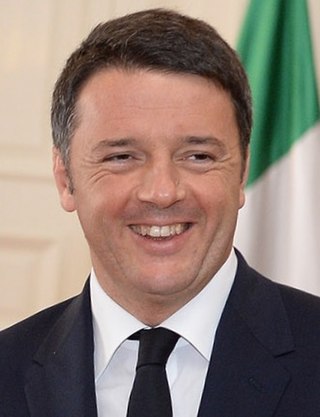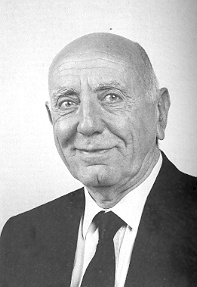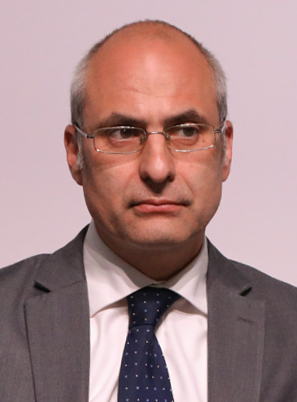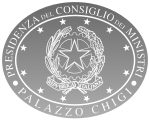
The prime minister of Italy, officially the president of the Council of Ministers, is the head of government of the Italian Republic. The office of president of the Council of Ministers is established by articles 92–96 of the Constitution of Italy; the president of the Council of Ministers is appointed by the president of the Republic and must have the confidence of the Parliament to stay in office.

The Polizia di Stato is one of the national police forces of Italy. Alongside the Carabinieri, it is the main police force for providing police duties, primarily to cities and large towns, and with its child agencies it is also responsible for highway patrol (autostrade), railways (ferrovie), airports (aeroporti), customs, as well as certain waterways, and assisting the local police forces.
Eight per thousand is an Italian law under which Italian taxpayers devolve a compulsory 8 ‰ = 0.8% from their annual income tax return to an organised religion recognised by Italy or, alternatively, to a state-run social assistance scheme.

The Council of Ministers is the principal executive organ of the Government of Italy. It comprises the President of the Council, all the ministers, and the Undersecretary to the Prime Minister. Deputy ministers and junior ministers are part of the government, but are not members of the Council of Ministers.

The Dipartimento delle Informazioni per la Sicurezza is a department of the Presidency of the Council of Ministers of Italy, instituted in 2007 as part of the reform of the Italian security services. The department is part of Sistema di informazione per la sicurezza della Repubblica. It is currently headed by Elisabetta Belloni, the successor to General Gennaro Vecchione.

The National Agency for the Safety of Flight is the Italian aviation accident investigation agency. The ANSV is headquartered in Rome. The italian Prime Minister oversees the agency.

The Ministry of the Interior is a government agency of Italy, headquartered in Rome. It is a cabinet-level ministry of the Italian Republic. As of October 2022, Matteo Piantedosi, former Prefect of Rome, is the minister.

The Palazzo del Viminale is a historic palace in Rome (Italy), seat of the Prime Minister and of the Ministry of Interior since 1925; in 1961 the Prime Minister was transferred to Palazzo Chigi.

The Renzi government was the 63rd government of the Italian Republic, in office from February 2014 to December 2016. It was led by Matteo Renzi, secretary and leader of the centre-left Democratic Party (PD).

Lorenzo Guerini is an Italian politician and member of the Democratic Party (PD). Guerini has been serving as the Italian Minister of Defence in the cabinets of successive prime ministers Giuseppe Conte and Mario Draghi from 2019 to 2022. In March 2014, he was chosen by party leader Matteo Renzi to be deputy secretary of the PD along with Debora Serracchiani, a position that he held until May 2017. From 2005 to 2012, he served as mayor of Lodi, Lombardy, his hometown.

The deputy prime minister of Italy, officially the vice-president of the Council of Ministers of the Italian Republic, is a senior member of the Italian Cabinet. Moreover, it is often colloquially known as Vicepremier. The office of the Deputy Prime Minister is not a permanent position, existing only at the discretion of the Prime Minister, who may appoint to other offices to give seniority to a particular Cabinet minister. The office is currently held by Matteo Salvini and Antonio Tajani under Giorgia Meloni's premiership.

The secretary of the Council of Ministers is a senior member of the Italian Cabinet. The secretary is one of the undersecretaries of state to the Presidency of the Council of Ministers but, unlike them, he sits in the Cabinet and helps the prime minister in coordinating the government and its meetings. Thus, the secretary is usually a person very close to the prime minister. The secretary of the Council of Ministers, which may not be confused with the largely ceremonial office of Deputy Prime Minister, resembles that of the White House chief of staff.

Luca Lotti is an Italian politician who served as the Minister for Sport from 2016 to 2018 in the Gentiloni Cabinet.

A Ministry of the Republic of Italy is an administrative organ of the Republic of Italy, placed at the top of Italian public administration and is characterised by one or more specific competencies, with an organised structure, often varying over time.

Antonio Rastrelli was an Italian politician and lawyer. He served as the President of Campania from 1995 until 1999.

Roberto Garofoli is an Italian magistrate and civil servant. He served as secretary of the council of ministers in the cabinet of Prime Minister Mario Draghi.
The 2021 Italian by-elections were held to replace members of the Italian Parliament. The elections were held on 3–4 October 2021.

Fabrizio Curcio is an Italian government official, who served as Head of the Civil Protection from 3 April 2015 to 8 August 2017 and again since 26 February 2021.
The Delegated Authority for the Security of the Republic is an Italian government agency within the Council of Ministers with the aim of coordinating the Prime Minister and intelligence agencies. The current officeholder is Alfredo Mantovano, Secretary of the Council of Ministers in the government of Giorgia Meloni.














